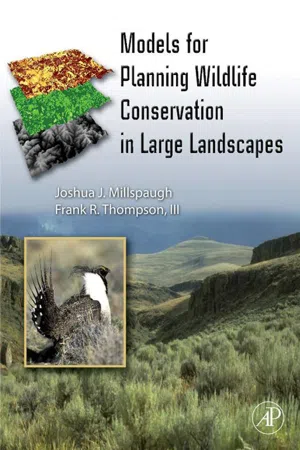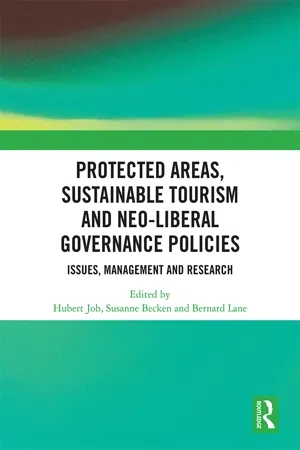Conservation Planning
Conservation planning involves the systematic assessment of natural resources and the development of strategies to protect and sustainably manage them. It aims to balance human needs with the preservation of biodiversity and ecosystems. This process typically involves identifying priority areas for conservation, setting goals, and implementing measures to achieve long-term environmental sustainability.
4 Key excerpts on "Conservation Planning"
- eBook - ePub
Land and Limits
Interpreting Sustainability in the Planning Process
- Richard Cowell, Susan Owens(Authors)
- 2005(Publication Date)
- Routledge(Publisher)
...In discussing these policies, and their connections with land-use planning, we concentrate on the strategic level rather than on details of management, regulation and development control, although we touch upon these where they show how policies are being interpreted on the ground. Our aim is to explore key issues at the interface of planning and nature conservation and appropriate frameworks for their treatment within the political process. We begin by considering the effects of a transition in conservationist thought from a reactive, primarily site-based approach to a more strategic and holistic view based on concepts of biodiversity. Land-use planning continues to be of great importance for site protection, but increasingly it is seen as a forum within which a more proactive and strategic approach to nature conservation can be defined and pursued. And since, in many areas, conservation of what has survived is not enough, it is an approach that must encompass increasing attention to habitat restoration and enhancement. In the UK, these changes are reflected in legislation and in guidance to local planning authorities (from government, statutory agencies and non-governmental organisations), and are set within an increasingly ambitious European policy framework for the protection of biodiversity. At the same time, emerging interpretations of sustainable development, particularly those grounded in concepts of environmental capital and capacity, have been influential in planning and nature conservation policy communities...
- Joshua Millspaugh, Frank R. Thompson(Authors)
- 2011(Publication Date)
- Academic Press(Publisher)
...However, such a strategy may in fact be setting the conservation bar too high and limiting our flexibility in considering reasonably good solutions in the real world where strong economic pressures make implementation of “the best” strategy politically infeasible (Possingham et al. 2000). For this reason, there is a need for geographic approaches that take a broader perspective—one that considers the landscape whole as well as the conserved parts. This is easier said than done, but it is a perspective that is extending landscape ecology from its traditional patch-based focus to one that treats the landscape as a continuum (Fischer and Lindenmayer 2006)—a shift that is also seen as facilitating the incorporation of ecological process into Conservation Planning and land management. Incorporating Ecological Process Geographic approaches to Conservation Planning have been dominated by the examination of patterns of noteworthy biodiversity features across the landscape (Pressey 2004). These biodiversity patterns manifest from a complex interaction of ecological processes (e.g., species dispersal, spatially explicit demographics, disturbance, succession, interspecific interactions, primary productivity) with human uses of the landscape (e.g., subsistence, land use conversion, resource extraction). These interactions are the drivers of ecosystem dynamics and the transitory nature of species occupancy patterns across the landscape (Sarkar et al. 2006). The observed temporal turnover in species begs the question: “Can static conservation designs protect the full complement of species suggested by the planning analyses?” (Cabeza and Moilanen 2001). Unfortunately, conservation science has yet to determine the best approaches for including the underlying ecological and socioeconomic processes into geographical approaches to Conservation Planning (Williams et al. 2005)...
- eBook - ePub
Urban Nature Conservation
Landscape Management in the Urban Countryside
- Stephen Forbes, Tony Kendle(Authors)
- 2013(Publication Date)
- Taylor & Francis(Publisher)
...5 Biogeography and Conservation Planning in the Urban Countryside It is becoming increasingly apparent that many of the assumptions underlying Conservation Planning have been too simplistic to guide management accurately, or to explain adequately all of the relationships seen between species and reserves. Slowly ecologists are developing an understanding of the ways in which broader habitat patterns, comprising shapes, sizes, internal structure and the spatial relationship between all of these and between the habitats and the surrounding landscape influence the diversity of species found within a reserve or wildlife area. The discipline of landscape ecology has been defined by the UK branch of the International Association of Landscape Ecology as the interactions between the temporal and spatial aspects of a landscape and its flora, fauna and cultural components (Griffith, 1995). In many ways it is a direct extension of the subject of biogeography. The subject grew largely out of the interests of central European biogeographers in the regional and local scale patterns and processes in the landscape (Naveh and Liebermann, 1994), although the terminology inevitably has become entangled and confused with those aspects of work of the landscape professions which have an ecological orientation, such as have been discussed in earlier chapters regardless of their scale. For the purposes of this chapter, the term landscape ecology is used in keeping with the above definition – the objective is to review the interaction between the pattern and distribution of habitats and sites within the urban fabric and to consider how the relationships between them may affect their function. The significance of such a study lies in its potential contribution towards strategic planning and the identification of areas where green space creation, protection and management strategies may be targeted towards regional benefits...
- eBook - ePub
Protected Areas, Sustainable Tourism and Neo-liberal Governance Policies
Issues, management and research
- Hubert Job, Susanne Becken, Bernard Lane(Authors)
- 2020(Publication Date)
- Routledge(Publisher)
...Protected Areas in a neoliberal world and the role of tourism in supporting conservation and sustainable development: an assessment of strategic planning, zoning, impact monitoring, and tourism management at natural World Heritage Sites Hubert Job, Susanne Becken and Bernard Lane ABSTRACT Societies collapse when there is an increasing natural resource scarcity and growing stratification of society into rich and poor. The neoliberal world of targets, business plans and short term economic justification in which we live exacerbates these risks to society. It is imperative to find new ways of governing natural ecosystems that protect them from these risks and allows usage that helps close the development gap. Tourism in Protected Areas (PAs) is one important vehicle to achieve sustainable conservation and development outcomes. This paper highlights that the increasing focus on promoting human activity, especially tourism, in and around PAs is increasingly enshrined in the mandate and governance structures of United Nations Educational, Scientific and Cultural Organisation natural World Heritage Sites and Biosphere Reserves. It reviews strategic planning, zoning, impact monitoring, and tourism management by analysing all 229 natural World Heritage Sites, revealing that both overall strategic planning and tourism planning in these sites need improvements, notably through more consistent monitoring systems. The paper concludes by exploring the benefits of embedding World Heritage Sites into Biosphere Reserves, with a particular focus on core zoning, regional product development, and improved monitoring standards, and suggests ways to disseminate good practice worldwide to all types of PAs. Introduction: the wider context Concern about planetary limits and the risks humankind is facing as a result of increasing environmental destruction is growing (Hall & Day, 2009)...



